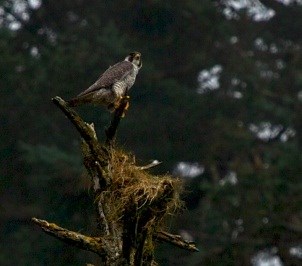
NPS Photo / K. Thoresen Falco peregrinus pealeiBasic InfoThere are three subspecies of peregrine falcon: Peale's, Arctic (also called 'tundra'), and American. Only the Peale's occurs in the Seward area. The scientific name Falco peregrinus means "falcon wanderer." The peregrine falcon's distinctive dark head and mustache give it a hooded appearance. Adults have a blue-grey back, and pale undersides with dark barring. The Peale's is the largest and darkest plumed of the peregrines. The bird's most obvious characteristic in the field is its speed. Called "nature's finest flying machine," peregrine falcons have been clocked traveling 220 miles per hour. Peregrine falcons weigh one-and-a-half pounds, and are approximately 16 inches long with a wingspan of about 41 inches. Habitat, Range and Local SightingsThe Peale's peregrine falcon resides on the coast from Washington to Alaska. Although the Arctic and American subspecies migrate 8,500 miles south into Argentina and Chile, most of the Peale's stay in Alaska. When food gets scarce, irruptive migration may occur. This type of migration is a response to food availability. Many captive-bred reintroductions around North America are Peale's, therefore this subspecies range extends across North America. On the bay tour, look for peregrine falcons at Emerald Cove, and the south sides of the Resurrection Peninsula and Barwell Island. Peregrines can also sometimes be found in the Cheval Narrows, on the east side of Matushka, and in the Beehive Islands. Food and Survival StrategiesPeregrine falcons specialize in aerial capture of birds. Flying high above their prey, falcons go into a stoop or dive reaching speeds of up to 200 miles per hour. The falcon hits its prey with talons and beak forward, killing on impact. If the bird is not killed, the falcon will finish it off with a bite to the neck using a special notch in the bill that all falcons have. Peregrine falcons are a top-level predator in our coastal ecosystem. Eagles may harass them at their nesting areas but their biggest threat comes from man. Organochlorides and other toxic pollutants create hazards for the birds. Weakening eggshells and decreasing productivity are common effects of pollutants. DDT has been banned in the U.S., but some falcons migrate to places in South America where the toxin is still used. Reproduction and YoungPeregrine falcons nest on rock ledges on high steep cliffs, often under an overhang. Instead of using a nest, they lay their eggs in a "scrape," or a protected rocky depression. Once established, the same pair of peregrine falcons will reuse a given nest site year after year. Peregrine falcons lay one clutch of three to four eggs each year. The female incubates the eggs while the male defends the nest and hunts for food. Eggs hatch after 30-32 days. The female parent stays with the young while the male keeps them fed. Baby falcons, called "eyasses," are completely helpless but grow to 10 times their birth size in three weeks. The young fledge 35 to 40 days after hatching, although the parents may continue to feed them for another few weeks. In the wild, peregrine falcons live about 15 years. Human ConnectionsThe sport of falconry, or hunting with trained falcons, has roots as far back as 2200 BC when the birds were used to hunt by the Heian dynasty in China. In 384 BC, Aristotle made reference to the sport in Europe. In medieval Europe, falconry was very popular and your station in life determined what bird you could use for hunting: A king could use a gyrfalcon, an Earl a peregrine, a yeoman a goshawk, and a priest a sparrow hawk. Current federal regulations allow the capture of wild peregrine falcon chicks in several western states, including Alaska. Permitted individuals raise and breed the birds. In 1970, the American and Arctic subspecies were listed as endangered. The population in 1974 hit a low of 324 nesting pairs. Populations had plummeted 90 percent in 40 years. Recovery efforts involved local, state and federal agencies, as well as private organizations. Recovery east of the Rockies had great success with falcons being released in major cities such as New York, Boston, and Chicago. These falcons nest on skyscrapers and feed on pigeons. By 1998, there were an estimated 5,000 nesting pairs in the United States. In 1999, President Clinton removed the bird from the endangered species list; however, it remains protected by the Migratory Bird Act. |
Last updated: March 16, 2018
